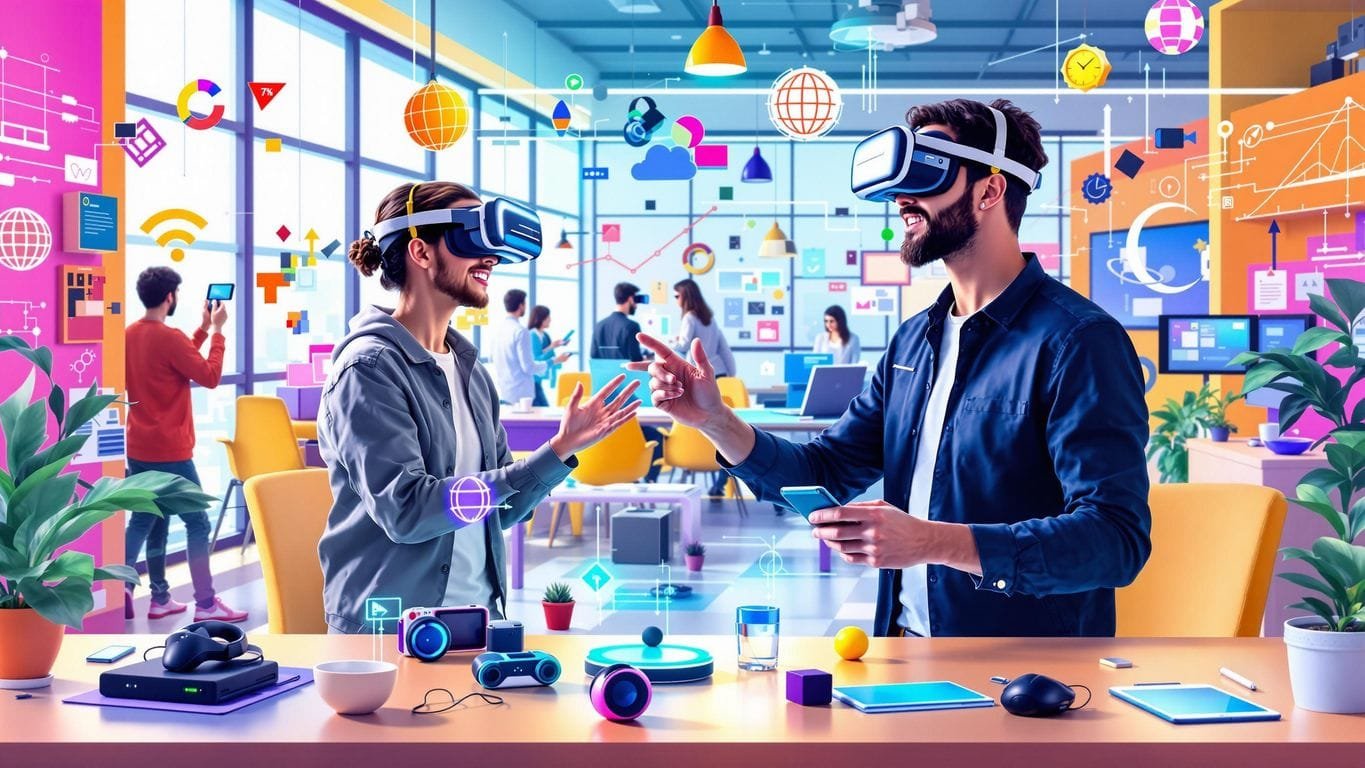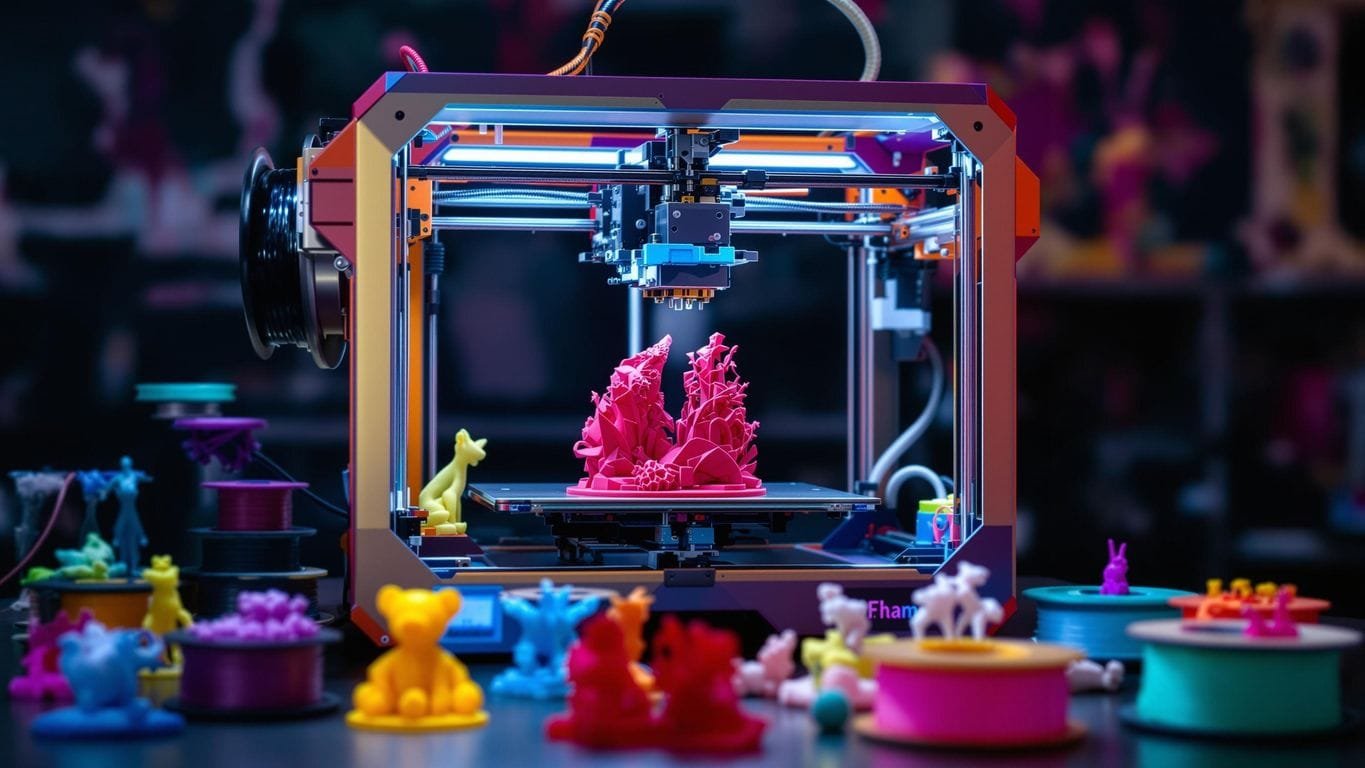

AR/VR Opportunities: Create Wealth with Emerging Tech Innovations
Hey, have you ever thought about how AR and VR are changing the game? Seriously, these tech wonders are not just for gamers anymore. They’re popping up everywhere, from schools to shopping malls. And guess what? There’s money to be made here. If you’re looking to cash in on the next big tech wave, AR and VR might just be your ticket.
Key Takeaways
- AR/VR isn’t just for gaming; it’s transforming industries like education and healthcare.
- The market for AR/VR is booming, with projections hitting over $165 billion by 2032.
- Investors are eyeing AR/VR as a hot opportunity, with both short-term and long-term potentials.
- Virtual real estate is emerging, offering new ways to own and invest in digital spaces.
- Building income with AR/VR technologies is about creating engaging content and experiences.
Understanding the AR/VR Landscape

Defining Augmented Reality and Virtual Reality
Augmented Reality (AR) and Virtual Reality (VR) are like siblings in the tech world, each with its own unique traits. AR enhances the real world by overlaying digital information onto our physical surroundings. Think of apps like Pokémon Go, where your phone camera shows digital creatures in your living room. On the flip side, VR transports you to a completely digital realm, cutting off the real world and immersing you in a new environment. This is the domain of gadgets like the Oculus Quest, where you can be on a virtual beach while sitting in your bedroom.
Current Market Trends and Projections
The AR/VR market is on a rocket ride upwards. As of now, it’s expected to hit around $300 billion by 2024. This boom is fueled by several factors:
- Technological advancements: Better, cheaper VR headsets and AR glasses are making these techs more accessible.
- Industry adoption: From healthcare to retail, various sectors are jumping on the AR/VR bandwagon.
- Growing consumer interest: As experiences become more immersive, more folks are getting curious and diving in.
Key Players in the AR/VR Industry
When it comes to AR/VR, a few giants are leading the charge. Companies like Facebook, with its Oculus brand, are big in VR. Meanwhile, Microsoft’s HoloLens is a major player in the AR space. Google and Apple are also dabbling in both realms, constantly pushing the boundaries of what’s possible. These key players are not just shaping the immersive experiences of today but are also setting the stage for tomorrow’s innovations.
As we stand on the brink of a new era in digital interaction, AR and VR are not just reshaping how we see the world—they’re redefining our very reality. The journey is just beginning, and the possibilities are endless.
Investment Opportunities in AR/VR
Venture Capitalist Insights on AR/VR
Venture capitalists are buzzing about the potential in AR/VR. AR is seen as a safer short-term bet, while VR holds the promise of being a massive long-term opportunity. Brayton Williams, a VC investor, mentions that AR complements our real world, but VR opens up entirely new worlds. Some VCs are particularly interested in the mobile and sports sectors as entry points for AR/VR. Companies like Wave VR, Rec Room, and VRChat are making waves by creating engaging experiences with devices people already own.
In the world of AR/VR, ambition and patience are key. Founders need to be flexible and ready to pivot, always keeping an eye on customer retention. It’s not just about creating something fun to try—it’s about making it habit-forming.
Emerging AR/VR Startups to Watch
There’s a whole new breed of startups making strides in AR/VR. The focus is on creating immersive experiences that go beyond gaming. Startups like Ramen VR and Medal are pushing the boundaries of what’s possible with VR. These companies are not just about entertainment; they’re exploring how AR/VR can enhance real-life sports and remote meetings. They’re making a mark by turning complex tech into something accessible and exciting.
Long-term vs Short-term Investment Strategies
When it comes to investing in AR/VR, it’s crucial to balance short-term gains with long-term potential. AR, with its immediate applications in industries like education and manufacturing, offers quicker returns. On the other hand, VR is more about the long game—think gaming and immersive experiences. Investors need to weigh the risks and rewards, considering factors like market readiness and technological advancements. The hardware space, often dominated by big names like Microsoft and Sony, requires significant capital and strategic partnerships, making it more suited for those with deep pockets.
In summary, the AR/VR landscape is rich with opportunities, from emerging startups to established giants. Whether you’re looking at short-term gains or long-term growth, there’s a path for every investor willing to explore this exciting field.
Transforming Industries with AR/VR

Revolutionizing Education and Training
AR and VR are changing how we learn and train. Imagine being able to practice surgery without any risk or virtually walk through historical sites from your classroom. These technologies offer immersive experiences that bring learning to life. They help students understand complex concepts by visualizing them in a 3D space. Schools and companies are using VR to simulate real-world scenarios, making training both safer and more effective.
- Interactive lessons keep students engaged.
- Reduces the cost of physical training materials.
- Offers a safe environment for high-risk training.
AR and VR are not just tools; they’re becoming integral to modern education, breaking down barriers and providing access to quality learning worldwide.
Innovations in Healthcare and Medicine
In healthcare, AR and VR are game changers. Doctors can now perform virtual surgeries to hone their skills or use AR to see detailed images of organs during operations. This tech is also used for patient education, helping them understand their conditions better.
- Enhances precision in surgeries.
- Assists in diagnosing with 3D imaging.
- Provides virtual therapy for mental health.
AR and VR technologies are revolutionizing traditional industrial processes by enhancing design, prototyping, training, and maintenance.
Enhancing Retail and E-commerce Experiences
Shopping is no longer just about buying; it’s about experiencing. AR allows customers to “try on” clothes or see how furniture looks in their home without stepping into a store. VR can create immersive shopping environments where customers can explore products in a virtual space.
- Increases customer engagement.
- Reduces return rates by helping customers make informed decisions.
- Offers personalized shopping experiences.
With AR and VR actively transforming various sectors, shopping is becoming more interactive and personalized, making these technologies a must-have for future-forward businesses.
Challenges and Solutions in AR/VR Development

Overcoming Technological Barriers
One of the biggest hurdles in AR/VR is the tech itself. Devices need to be lighter, faster, and more affordable. VR headsets, for instance, can be bulky and uncomfortable, making long sessions tough. Improvements like better sensors and wireless capabilities are crucial. But here’s the catch: these advancements aren’t cheap. Companies need to invest big bucks to make tech that’s both cutting-edge and cost-effective.
- Miniaturization and weight reduction are key.
- Enhanced wireless tech for seamless experiences.
- Cost-effective manufacturing to boost consumer adoption.
Addressing Privacy and Security Concerns
With AR/VR, privacy is a big deal. These systems collect tons of personal data, from location to biometric info. Securing this data is vital to prevent breaches. Businesses must implement strong security measures. This isn’t just about tech; it’s about trust. If users don’t feel safe, they won’t engage.
- Develop robust encryption protocols.
- Regularly update security systems.
- Educate users about data protection.
Ensuring User Adoption and Retention
Getting people to try AR/VR is one thing; keeping them engaged is another. The novelty can wear off fast if the experience isn’t up to par. Engaging content is essential, but so is ease of use. Think user-friendly interfaces and intuitive controls. Also, consider the social aspect. Platforms that promote community and interaction, like VR Chat, can boost retention.
“In the world of AR/VR, it’s not just about creating tech; it’s about crafting experiences that people want to return to again and again.”
The Future of Virtual Real Estate
Imagine walking down a busy street and seeing a bustling store, but it’s not physically there. That’s the magic of AR-only commercial spaces. These are digital storefronts or offices that exist entirely in augmented reality, accessed at specific physical locations. Businesses can set up shop in high-traffic areas without worrying about rent or maintenance. This flexibility allows retailers to innovate and reach consumers in unique ways, offering a whole new shopping experience.
Owning digital real estate is becoming a reality, much like owning a physical plot of land. In the digital world, you can buy and sell AR rights to specific locations, allowing businesses to project digital storefronts or interactive ads through AR lenses. This could be a game-changer, creating a new kind of real estate competition where digital layers over popular areas become highly sought after.
As cities become smarter, the integration of AR into public infrastructure could revolutionize real estate. Imagine walking through a park and seeing digital art galleries or interactive maps that provide real-time property data. This blend of virtual and physical spaces could redefine how we interact with our surroundings, making smart cities more engaging and informative.
The future of real estate is not just physical—it’s digital, immersive, and interactive. Companies that embrace this shift will lead the way, creating new revenue streams and delivering more engaging experiences for their clients.
With the rise of virtual properties and digital storefronts, the demand for innovative AR/VR solutions in real estate is expected to grow, offering profitable opportunities for early investors. The integration of AI with VR and AR further enhances these experiences, making property viewing more dynamic and accessible. As these technologies evolve, those who invest in understanding and adopting them early will have a significant competitive advantage. The potential for digital ownership is huge, making it a sought-after asset in the modern world.
The future is here, and it’s digital. Whether it’s through smart home innovations or VR experiences, the real estate industry is on the brink of a major transformation. Embracing these changes could lead to new opportunities and a more engaging experience for all involved.
Building Income with AR/VR Technologies
Monetizing AR/VR Content and Experiences
Creating income through AR/VR is all about tapping into the endless possibilities these technologies offer. Imagine crafting a virtual world where users can interact, learn, and shop. Developers and creators can charge for access to these worlds or offer premium features.
- Subscription Models: Offer users access to exclusive content or experiences for a monthly fee.
- In-App Purchases: Allow users to buy virtual goods or upgrades within your AR/VR apps.
- Advertising: Integrate brands into your AR/VR experiences, creating immersive ads that users can interact with.
With AR/VR, the only limit is your imagination. These technologies allow creators to build entirely new worlds and experiences, offering endless opportunities to monetize.
Creating AR/VR-Based Business Models
Building a business around AR/VR isn’t just for tech giants. Even small businesses can get in on the action. Startups are developing apps that let users try on clothes virtually or visualize furniture in their homes. These innovations can attract customers who appreciate the convenience and novelty.
- Virtual Try-Ons: Let customers see how products look in their environment before buying.
- Training Simulations: Offer businesses realistic training environments without the physical risks.
- Virtual Tours: Provide real estate agents and tourism companies with tools to showcase properties and destinations remotely.
Leveraging AR/VR for Marketing and Branding
AR/VR can transform traditional marketing, making it more engaging and interactive. Brands are using these technologies to create experiences that go beyond simple ads.
- Interactive Storytelling: Let customers explore the brand’s story through immersive experiences.
- Virtual Events: Host events in a virtual space, allowing global participation without travel.
- Augmented Product Displays: Use AR to show customers how products fit into their lives, enhancing their buying confidence.
Explore opportunities to earn money online through virtual reality and augmented reality, tapping into the potential of these innovative fields.
AR/VR isn’t just about fun and games. It’s a serious business tool that can change how companies connect with their audience. By integrating AR/VR into marketing strategies, businesses can stand out in a crowded market.
Gaming and Entertainment Beyond Fun

Immersive Gaming Experiences
Gaming has always been about excitement and adventure, but with AR and VR, it’s like stepping into another world. Imagine playing a game where you don’t just control a character, but you become that character. This is the future of gaming, where players experience environments as if they were real. The level of immersion is staggering, making games more engaging than ever. This isn’t just about better graphics; it’s about creating worlds that feel alive.
- Total Immersion: VR headsets now offer 360-degree views, making players feel like they’re in the middle of the action.
- Interactive Environments: Games now allow players to interact with their surroundings in ways that were impossible before.
- Realistic Feedback: Devices like haptic suits give physical feedback, making the experience more tangible.
Gaming is no longer just a hobby; it’s a portal to new realities, offering experiences that were once only dreams.
AR/VR in Sports and Fitness
Sports and fitness have jumped on the AR/VR bandwagon, transforming how we train and compete. Imagine training for a marathon with a virtual coach guiding you every step of the way. Or playing tennis against a virtual opponent who adapts to your skill level. This tech isn’t just for fun—it’s a serious tool for athletes and fitness enthusiasts.
- Virtual Training Partners: Train with AI coaches who can adjust to your performance.
- Enhanced Reality Games: Compete in sports where the lines between real and virtual blur.
- Fitness Gamification: Turn workouts into games to make exercise more engaging.
Expanding into Non-Entertainment Sectors
AR and VR aren’t just about fun and games anymore. They’re making waves in fields you wouldn’t expect, like education, healthcare, and even real estate. These technologies are helping surgeons practice complex operations and students learn in immersive environments. The possibilities are endless.
- Educational Tools: Students can explore historical sites or conduct science experiments in virtual labs.
- Healthcare Innovations: Surgeons can practice procedures in a risk-free virtual space.
- Virtual Real Estate Tours: Prospective buyers can “walk through” properties without leaving their homes.
Hybrid AR/VR gaming is not just about entertainment; it’s about creating new opportunities in various fields, making technology an integral part of everyday life.
Gaming isn’t just about having fun; it’s a way to connect, learn, and grow. Dive into the world of gaming and discover how it can open doors to new experiences and opportunities. Want to learn more? Visit our website for tips and insights that can change your gaming journey!
Conclusion
So, there you have it. AR and VR are not just buzzwords anymore; they’re shaping up to be real game-changers. From gaming to healthcare, these technologies are opening doors we didn’t even know existed. Sure, there are hurdles to jump over—like making the tech more user-friendly and affordable—but the potential is massive. If you’re thinking about diving into this world, now’s the time. The landscape is ripe for innovation, and who knows? You might just find yourself at the forefront of the next big thing. So keep an eye on this space, because it’s only going to get more exciting from here.
👉 Join Our Community for More Insights!
Subscribe to The Millionaire Playbook for:
- Weekly strategies to grow income streams.
- Proven tools and templates to fast-track success.
- Exclusive guides to launch your Fastlane business.
Frequently Asked Questions
What is the difference between AR and VR?
AR, or Augmented Reality, adds digital stuff to the real world, like Pokémon Go. VR, or Virtual Reality, puts you in a whole new world, like a video game you can walk around in.
Why are people investing in AR and VR technology?
People see AR and VR as the next big thing because they can change how we learn, play, and shop. Investors want to be part of this exciting future.
How is AR/VR used in education?
AR and VR can make learning fun and safe. For example, students can explore the solar system or practice dangerous tasks without leaving the classroom.
What are some challenges AR/VR developers face?
Developers need to make AR/VR gear lighter and cheaper. They also need to keep our personal info safe while making sure the tech is easy to use.
Can AR/VR really change shopping?
Yes! With AR/VR, you can try on clothes or see how furniture looks in your room without going to the store. It makes shopping easier and more fun.
What does the future hold for virtual real estate?
In the future, we might buy digital land where businesses can set up virtual stores or ads. It’s like owning a piece of the internet.








